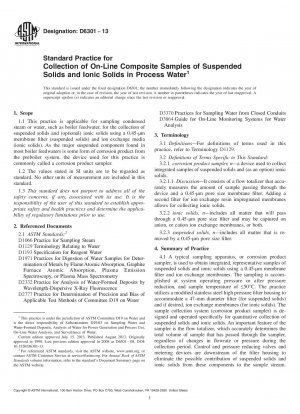ASTM D6301-13
Standard Practice for Collection of On-Line Composite Samples of Suspended Solids and Ionic Solids in Process Water
- Standard No.
- ASTM D6301-13
- Release Date
- 2013
- Published By
- American Society for Testing and Materials (ASTM)
- Status
- Replace By
- ASTM D6301-21
- Latest
- ASTM D6301-21
- Scope
5.1 The transport of any suspended solids or corrosion products from the preboiler cycle has been shown to be detrimental to all types of steam generating equipment. Corrosion product transport as low as 10 ppb can have significant impact on steam generators performance.
5.2 Deposited corrosion products on PWR steam generator tubes can reduce heat transfer, and, if the deposit is sufficiently thick, can provide a local area for impurities in the bulk water to concentrate, resulting in a corrosive environment. In BWR plants, the transport of corrosion products can cause fuel failure, out of core radiation problems from activation reactions, and other material related problems.
5.3 In fossil plants, the transport of corrosion products can reduce heat transfer in the boilers leading to tube failures from overheating. The removal of these corrosion products by chemical cleaning is expensive and potentially harmful to the boiler tubes.
5.4 Normally, grab samples are not sensitive enough to detect changes in the level of corrosion product transport. Also, system transients may be missed by only taking grab samples. An integrated sample over time will increase the sensitivity for detecting the corrosion products and provide a better understanding of the total corrosion product transport to steam generators.
1.1 This practice is applicable for sampling condensed steam or water, such as boiler feedwater, for the collection of suspended solids and (optional) ionic solids using a 0.45-μm membrane filter (suspended solids) and ion exchange media (ionic solids). As the major suspended component found in most boiler feedwaters is some form of corrosion product from the preboiler system, the device used for this practice is commonly called a corrosion product sampler.
ASTM D6301-13 Referenced Document
- ASTM D1066 Standard Practice for Sampling Steam
- ASTM D1129 Standard Terminology Relating to Water
- ASTM D1193 Standard Specification for Reagent Water
- ASTM D1971 Standard Practices for Digestion of Water Samples for Determination of Metals by Flame Atomic Absorption, Graphite Furnace Atomic Absorption, Plasma Emission Spectroscopy, or Plasma Mass Spectrometry
- ASTM D2332 Standard Practice for Analysis of Water-Formed Deposits by Wavelength-Dispersive X-Ray Fluorescence
- ASTM D2777 Standard Practice for Determination of Precision and Bias of Applicable Methods of Committee D-19 on Water
- ASTM D3370 Standard Practices for Sampling Water from Closed Conduits
- ASTM D3864 Standard Guide for Continual On-Line Monitoring Systems for Water Analysis
ASTM D6301-13 history
- 2021 ASTM D6301-21 Standard Practice for Collection of On-Line Composite Samples of Suspended Solids and Ionic Solids in Process Water
- 2013 ASTM D6301-13 Standard Practice for Collection of On-Line Composite Samples of Suspended Solids and Ionic Solids in Process Water
- 2008 ASTM D6301-08 Standard Practice for Collection of On-Line Composite Samples of Suspended Solids and Ionic Solids in Process Water
- 2003 ASTM D6301-03 Standard Practice for the Collection of Samples of Filterable and Nonfilterable Matter in Water
- 1998 ASTM D6301-98 Standard Practice for the Collection of Samples of Filterable and Nonfilterable Matter in Water
